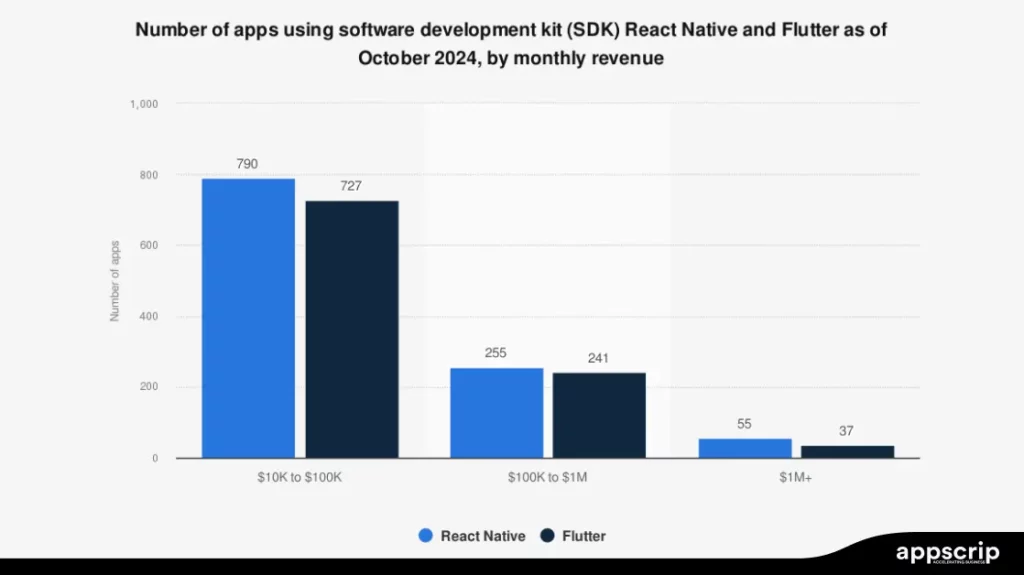You have a great app idea, but now comes the big question: which framework will help you build it faster and smarter? React Native vs Flutter are two of the top choices for cross-platform development, each with its own strengths. Choosing the right mobile app development framework will save you time, money, and plenty of frustration down the road.
At Appscrip, we’ve worked with startups and businesses of all sizes to build high-performance apps. Whether you need a quick MVP to test the market or a fully scalable app built for growth, we know how to match the right framework to your business goals. Let’s explore the differences so you can make the best choice for your app.
TL;DR
- React Native (Meta) and Flutter (Google) are top cross-platform frameworks.
- React Native is best for web-to-mobile adaptability and faster development.
- Flutter offers better performance, smoother UI, and fewer bugs by compiling directly to native code.
- React Native speeds up development by 30-40% with 90% code reuse, while Flutter achieves near 100% reusability and 50% faster UI coding.
- Hiring costs: React Native devs $40K-$180K, Flutter devs $50K-$200K.
- React Native may slow down in complex apps due to the JavaScript bridge, while Flutter performs better in UI-intensive apps.
- Pre-built solutions offer the fastest launch and budget-friendly development, reducing both time and costs.
React Native & Flutter – What Are They and How Do They Work?
Before you dive into coding, it’s important to know how these frameworks actually work. React Native and Flutter both allow you to build cross-platform mobile apps, but they take different approaches to achieve this. So, how do they stack up? Let’s take a look.
React Native
Developed by: Meta (formerly Facebook)
Language Used: JavaScript
Why Developers Like React Native
- Since React Native is built on JavaScript, one of the most widely used programming languages, developers with web experience can quickly adapt to mobile development.
- With a vast library of third-party plugins, pre-built components, and integrations, developers can speed up development by using existing tools instead of coding everything from scratch.
- Features like hot reloading allow developers to see changes instantly while coding, reducing time spent refreshing or recompiling the app.
- Companies that already have web applications can reuse significant portions of their code, saving both time and money.
- React Native bridges the gap between JavaScript and native mobile capabilities, allowing apps to use essential features like GPS, camera, Bluetooth, and push notifications without needing a completely native approach.
React Native acts as a bridge between JavaScript and native components, letting developers write one codebase that runs on both iOS and Android. Apps like Instagram and Airbnb use React Native to ensure fast development cycles while maintaining a native-like experience.
It doesn’t compile directly into native code but instead communicates with native elements through a JavaScript bridge. This makes it flexible but may cause slight performance lags in highly complex applications.
Flutter
Developed by: Google
Language Used: Dart
Why Developers Like Flutter
- Instead of using platform-specific UI elements like React Native, Flutter draws its own UI components from scratch. This ensures the app looks identical across iOS and Android, reducing inconsistencies.
- Flutter provides a large selection of built-in UI widgets, making it easier to create high-quality user interfaces without relying on third-party libraries.
- Unlike React Native, which relies on a JavaScript bridge, Flutter compiles directly into native code. This makes it much faster and more efficient, especially for animations and heavy processing tasks.
- Many essential features like state management, navigation, and testing are built into Flutter, reducing the need for third-party dependencies and minimizing compatibility issues.
- Flutter’s Skia graphics engine is optimized for rendering smooth animations, transitions, and detailed UI elements, making it a top choice for visually immersive applications.
Flutter takes a different approach by rendering everything from scratch using its Skia engine. Apps like Google Pay and BMW’s mobile app use Flutter to deliver smooth animations and a visually rich user experience across multiple devices.
Instead of relying on native components, it draws UI elements directly onto the screen, ensuring a highly consistent experience across devices. This results in smoother animations and better performance for apps that require intensive graphics or real-time interactions.
Quick-Glance Framework Guide: Choose the Right One for Your App
To help you decide faster, here’s a quick comparison of React Native and Flutter based on key factors.
| If You Need | React Native | Flutter |
| The fastest MVP launch | More developers available, easier setup | Pre-built UI components speed up design |
| Best performance and UI | Good but depends on native modules | Runs smoother with built-in rendering engine |
| Cheapest development cost | More affordable developers | Slightly higher initial cost but fewer long-term updates |
| Easiest maintenance | More third-party dependencies, requires updates | Fewer dependencies, lower maintenance hassle |
| Scalability for growth | Good for integrations and web-to-mobile apps | Better at handling high user traffic and real-time updates |
| More integrations with existing tools | Works well with third-party APIs and plugins | More self-contained, requires fewer external tools |
| Security for fintech or healthcare apps | Flexible security features but needs third-party support | Stronger built-in encryption and compliance options |
What This Means for Your App
- Go with React Native if you need to launch quickly, keep costs low, or integrate with existing web apps.
- Choose Flutter if you want a high-performance app with a smooth UI and long-term stability.
If you need more context, we’ll take a deeper look at which framework gets your app live faster.
Speed-to-Launch Test – Which Framework Gets You Live Faster?
The right framework can shave weeks or even months off your timeline, helping you get to users faster. It’s also influenced by factors like code reusability, debugging efficiency, and how smoothly your app gets through app store approvals. So, how do React Native and Flutter compare when it comes to time-to-market? Let’s break it down.
Development Timelines & Team Size
| Framework | Time to Build | Team Size |
| React Native | 3-4 months | 4-6 people |
| Flutter | 3-4 months | 4-6 people |
| Pre-built Solutions | 1-2 months | 2-3 people |
Which One Gets You to Market Faster?
A report by LeanCode found that Flutter adoption has grown significantly, particularly among startups that need to develop MVPs quickly. Meanwhile, companies using React Native often report faster initial builds due to JavaScript familiarity and the ability to repurpose existing code.
- React Native is the better choice if you already have a JavaScript team and need to get an MVP out quickly.
- Flutter is the better choice if you want a polished UI and long-term performance stability, even if the initial setup takes a little longer.
What Impacts Time to Market?
Several factors influence how quickly you can build and launch an app. Here are the key performance indicators (KPIs) that determine your speed to market:
Code Reusability Rate
- React Native: Allows up to 90% code reuse between iOS and Android, meaning fewer development hours spent on platform-specific coding.
- Flutter: Achieves nearly 100% reusability due to its widget-based architecture, reducing time spent on platform adjustments.
Feature Implementation Speed
- React Native: Developers can integrate new features quickly using JavaScript and React’s vast ecosystem of third-party libraries. However, reliance on third-party packages can sometimes slow down complex implementations due to compatibility issues.
- Flutter: With pre-built UI widgets, developers can cut UI coding time by up to 50%, making it significantly faster for visually rich applications.
Third-Party Dependencies
- React Native: Heavy reliance on third-party libraries can sometimes lead to compatibility challenges when OS updates roll out.
- Flutter: Since Flutter has more built-in widgets and tools, it reduces dependency on external packages, minimizing integration delays.
Debugging & Issue Resolution
- React Native: Debugging can take longer due to third-party dependencies and the JavaScript bridge, which introduces an extra layer of complexity.
- Flutter: Comes with built-in testing tools for unit, widget, and integration testing, reducing debugging time and improving stability.
App Store Approval Time
- React Native: Because it relies on native components and third-party libraries, some additional fixes may be required before approval.
- Flutter: Compiles directly into native code, reducing compatibility issues and often leading to faster app store approval.
Speeding Up Development & Testing
- React Native: Hot reloading lets developers see changes instantly, cutting down iteration time.
- Flutter: Stateful hot reload enables real-time UI tweaks, making it easier to test and refine.
The Cheat Code a.k.a Pre-Built Solutions
While both frameworks can deliver an app within 3-4 months, businesses looking for an even faster launch often turn to pre-built solutions.
These pre-built solutions offer ready-made pre-validated features, and faster deployment, cutting development time down to as little as 1-2 months. For businesses prioritizing speed, leveraging pre-built components can be a game-changer.
But development and time-to-market speeds aren’t the only factors to consider while choosing a framework, we can also take a closer look at how each framework impacts development costs.

Budget and Development Costs: Which One Saves You Money?
The framework you choose directly impacts your development costs, maintenance expenses, and long-term scalability. Whether you go with React Native or Flutter, understanding the financial breakdown helps you make an informed decision that fits your budget and business goals.
Development Costs: React Native vs Flutter
The cost of building an app depends on its complexity. Let’s break it down:
| App Complexity | Framework | Development Cost | Maintenance Cost (Per Year) | Examples |
| Simple Apps (Weather & Productivity Apps) | React Native | $50,000 – $100,000 | $10,000 – $15,000 (frequent updates for third-party dependencies) | AccuWeather, Todoist, Google Tasks |
| Flutter | $50,000 – $100,000 | $10,000 – $15,000 (built-in UI components reduce reliance on external tools) | ||
| Medium Complexity Apps (E-commerce & Fitness Apps) | React Native | $100,000 – $200,000 | $15,000 – $25,000 (depends on third-party integrations and updates) | Etsy, WooCommerce, Nike Run Club |
| Flutter | $100,000 – $200,000 | $15,000 – $25,000 (native widgets minimize the need for third-party dependencies) | ||
| Highly Complex Apps (Ride-Sharing & Social Media Apps) | React Native | $200,000 – $350,000 | $25,000 – $40,000 (continuous updates needed for performance optimization) | Uber, Lyft, Instagram, Twitter |
| Flutter | $200,000 – $350,000 | $25,000 – $40,000 (lower reliance on third-party dependencies, reducing update complexity) |
Hiring Costs
The availability of skilled developers influences overall project expenses.
| Framework | Junior Developer | Mid-Level Developer | Senior Developer | Hiring Considerations |
| React Native | $40,000 – $70,000 | $70,000 – $120,000 | $120,000 – $180,000 | Larger developer pool, making recruitment easier and often more cost-effective. |
| Flutter | $50,000 – $80,000 | $80,000 – $130,000 | $130,000 – $200,000 | Fewer experienced Flutter developers, which may lead to longer hiring times and higher salaries. |
Which One Saves You More Money?
- React Native is budget-friendly upfront, especially if you already have JavaScript developers.
- Flutter may save more in the long run, as it requires fewer updates and has a more stable ecosystem.
For businesses looking to optimize costs without compromising on quality, pre-built solutions offer an even more budget-friendly alternative. By using a ready-made foundation, you can reduce development time, cut costs, and still get a high-performance app that scales with your business.
Security and Data Protection: Which One is Safer?
Whether handling user credentials, financial transactions, or healthcare records, any security gap can lead to data breaches, compliance violations, and loss of trust. Choosing the right framework impacts your app’s security from day one. Let’s break down how React Native and Flutter compare in protecting your app and its data.
Built-in Security Features
React Native:
- Security is largely dependent on third-party libraries, giving developers flexibility but requiring extra diligence.
- It supports authentication through libraries like Firebase Authentication and Auth0.
- Secure storage solutions include Expo SecureStore and React Native Keychain.
- React Native relies on community-driven security updates and best practices rather than native enforcement.
Flutter:
- Flutter comes with more built-in security tools, reducing dependency on third-party libraries.
- Native secure storage is supported through flutter_secure_storage for encrypted local data handling.
- It uses platform-specific security implementations, offering a more streamlined security model.
- Direct compilation to native code reduces security risks associated with third-party bridges.
Data Encryption & API Security
React Native:
- It requires external libraries like crypto-js for data encryption.
- API communication security depends on manual implementation of SSL pinning and secure key management.
- Token-based authentication (OAuth, JWT) must be configured using external providers.
Flutter:
- The built-in cryptographic libraries in Flutter framework simplify encryption, making it easier to secure stored data.
- Better native support for SSL pinning and certificate validation to prevent man-in-the-middle attacks.
- Stronger encryption handling for sensitive data with secure methods for API communication.
Industry Compliance & Regulations
React Native:
- React Native can meet industry compliance standards like GDPR, HIPAA, and PCI-DSS, but security must be carefully configured by developers.
- It requires integrating tools for secure payment processing (e.g., Stripe, Braintree) and healthcare data encryption (e.g., AWS Cognito for HIPAA compliance).
Flutter:
- Easier to align with GDPR, HIPAA, and PCI-DSS due to more built-in security controls.
- Flutter provides robust encryption, helping businesses comply with data protection regulations with less manual effort.
- Works well for industries requiring secure user authentication, encrypted transactions, and compliance auditing without extensive third-party reliance.
Which One is Safer?
- React Native offers flexibility but requires careful configuration and strong reliance on third-party tools to achieve high security.
- Flutter provides a stronger built-in security foundation, making it a better choice for apps with strict compliance and advanced data protection needs.
Scaling Your App: Which One Grows with Your Business?
As user numbers grow and features expand, your app needs to handle increasing traffic, updates, and performance demands. The framework you choose plays a key role in how easily your app can scale. Let’s take a detailed look at how React Native and Flutter manage growth from a developer’s perspective.
Handling High User Traffic
React Native:
- It can handle high user traffic, but performance may degrade if state management and API requests are not optimized.
- Large apps need extra performance enhancements, like reducing re-renders, optimizing animations, and offloading heavy computations to the backend.
- Apps like Instagram and Airbnb use React Native but depend on native modules to improve responsiveness under high traffic.
Flutter:
- Flutter is more efficient at handling high traffic loads due to its compiled nature and direct-to-native rendering.
- Multithreading support allows background tasks to run smoothly without affecting app performance.
- Used by Google Pay and BMW’s mobile apps to ensure seamless transactions and real-time interactions without performance drops.
Third-Party Integrations & Feature Expansion
React Native:
- React Native has a strong ecosystem with extensive third-party libraries, making it easier to expand app functionality.
- It works well with existing web technologies and backend services.
- Developer reports indicate 60% of React Native projects require at least one native module integration for full functionality.
Flutter:
- It has growing third-party support but still fewer libraries than React Native.
- Strong integration with Google’s ecosystem, including Firebase and Google Cloud.
- Some native integrations require platform-specific coding, increasing complexity.
- Google states that Flutter apps typically use 30% fewer external dependencies than React Native apps, simplifying maintenance.
Long-Term Maintenance & Updates
React Native:
- Frequent updates required to maintain compatibility with third-party libraries and OS updates.
- Apps dependent on third-party modules may experience compatibility issues over time.
- Meta actively maintains React Native, but developers need to stay updated with library changes.
Flutter:
- Google closely manages Flutter’s updates, ensuring more stable releases and fewer dependency-related issues.
- Built-in widgets reduce reliance on external libraries, leading to fewer maintenance challenges.
- Apps require fewer major updates since Flutter’s ecosystem is more predictable and tightly integrated.
According to SlashData’s latest report, companies using Flutter reported a 20% lower long-term maintenance cost than those using React Native. If you expect rapid user growth, Flutter’s optimized performance makes it a strong contender. However, if you need flexibility and deep third-party integrations, React Native remains a practical option.
Common Mistakes When Choosing a Framework
Picking the right framework for your app is a decision that affects how well your app performs, scales, and adapts to future growth. Yet, many startups and developers rush this decision, often making costly mistakes that could have been avoided. Let’s go through the most common mistakes.
Picking a Framework Based on Popularity: Just because a framework is widely used doesn’t mean it’s the right fit for your app. React Native is great for web-to-mobile compatibility, while Flutter is better for highly customized UI and long-term performance. Focus on what your app truly needs instead of following trends.
Ignoring Long-Term Maintenance Costs: Development costs are only part of the equation, maintenance costs add up over time. React Native relies on third-party libraries that need frequent updates, while Flutter has a more stable, built-in ecosystem, reducing ongoing maintenance efforts.
Underestimating Performance Needs: React Native’s JavaScript bridge can cause delays in real-time applications or animation-heavy apps. Flutter, which compiles directly to native code, offers smoother performance. If your app relies on responsiveness, choosing the right framework upfront is crucial.
Overlooking Developer Availability: React Native benefits from a larger talent pool due to its JavaScript foundation, making hiring easier. Flutter developers, while increasing in number, are still fewer, which may lead to longer hiring times and higher salaries.
Not Planning for Integrations: Most apps need third-party services like payment gateways and authentication. React Native has a strong library ecosystem, but dependencies require regular updates. Flutter’s ecosystem is growing but may require additional development effort for some integrations.
Next, we’ll explore real-world examples of businesses using React Native and Flutter effectively.
How Top Companies Use React Native and Flutter
Many well-known companies have successfully built and scaled apps using React Native and Flutter. Whether it’s for speed, performance, or cross-platform consistency, businesses worldwide are leveraging these frameworks to reach millions of users. Let’s take a look at some real-world examples and why these companies made their choices.
Companies Using React Native
Instagram: Instagram adopted React Native to introduce new features faster without rewriting the entire app. This allowed their team to reuse code between iOS and Android while maintaining the native feel that users expect. With React Native, Instagram improved development efficiency and kept both versions of the app in sync with fewer resources.
Uber Eats: Uber Eats uses React Native for its restaurant dashboard, where speed and efficiency are critical. React Native helped Uber Eats create a seamless web-to-mobile experience, allowing restaurant owners to manage orders and deliveries from different devices while maintaining consistency across platforms.
Walmart: Walmart switched to React Native to improve performance while keeping costs in check. By sharing nearly 95% of the codebase across platforms, Walmart reduced development time and resources while maintaining an optimized shopping experience for millions of users.
Companies Using Flutter
Google Pay: Google Pay migrated to Flutter to unify its mobile app across different regions. Flutter’s fast rendering engine and smooth UI components ensured a seamless transaction experience. Google Pay serves over 150 million users across 42 countries, and Flutter’s efficiency helps manage that scale with ease.
BMW: BMW uses Flutter to power its customer-facing mobile app, which provides remote car control, navigation assistance, and vehicle diagnostics. Flutter’s native performance and strong animations make it an ideal choice for BMW’s high-end user experience, with over 12 million app downloads globally.
Alibaba: Alibaba, one of the world’s largest e-commerce platforms, turned to Flutter to optimize its mobile shopping experience. With over 1 billion active users, Flutter’s ability to handle high traffic while providing a smooth UI experience made it a natural fit for the company’s long-term goals.
Lessons from Top Companies Adopting React Native and Flutter
- React Native is ideal for companies looking to reuse code across platforms and integrate with existing web services. It works well for apps that require frequent updates, rapid feature development, and broad device compatibility.
- Flutter is a great choice for businesses that need high-performance apps with custom UIs and animations. It’s a preferred solution for financial apps, automotive industries, and e-commerce giants handling millions of transactions.
The Right Development Team: Bringing Your App to Life
Choosing React Native vs Flutter is only part of the journey. The real challenge is turning your idea into an app that performs well, scales effortlessly, and delivers a great user experience.
What to Look for in a Development Team
Beyond technical skills, a strong development team understands your vision and business goals. Here’s what to prioritize:
Expertise in Your Chosen Framework
- React Native: Proficiency in JavaScript, TypeScript, Redux, and optimizing for native-like performance.
- Flutter: Strong experience with Dart, widget-based UI development, and platform-specific customizations.
Proven Track Record
- Experience in your industry. Have they built apps similar to yours?
- Solid client reviews and case studies showing successful projects.
A Focus on UI/UX Excellence
- A well-built app means nothing if users struggle to navigate it.
- Look for designers who create smooth, engaging, and intuitive experiences.
Why Appscrip is the Right Choice
At Appscrip, we go beyond just coding. We help businesses build scalable, high-performance apps that stand out. Whether you need an MVP or a full-featured mobile platform, we offer:
- Expert development in React Native & Flutter, tailored to your business needs.
- End-to-end services, from strategy and design to deployment and scaling.
- Long-term support, ensuring your app stays optimized, secure, and future-ready.
Ready to turn your idea into a powerful, scalable app? Let’s make it happen. Get in touch with us today and start building the future of your business!
FAQs
Can I switch from React Native to Flutter (or vice versa) after development starts?
Yes, but it can be costly and time-consuming. Since both frameworks have different architectures and languages, switching mid-development means rewriting a significant portion of your codebase. If you’re unsure, it’s best to analyze your long-term goals before committing to a framework. While migrating is possible, it requires careful planning to avoid unnecessary delays and expenses.
Are React Native and Flutter suitable for enterprise-level applications?
React Native is often chosen for corporate apps that need web-to-mobile compatibility and strong integration with existing enterprise software. Flutter is a better fit for performance-heavy applications with complex UI since it provides a more consistent experience across multiple devices.
Which framework is more cost-effective in the long run?
React Native has lower initial costs due to the large JavaScript developer pool, making hiring more affordable. However, Flutter reduces long-term maintenance costs since it has fewer third-party dependencies and a more stable ecosystem, requiring fewer updates. The best choice depends on whether you prioritize lower upfront costs (React Native) or lower long-term maintenance costs (Flutter).
What is the fastest way to launch an app using React Native or Flutter?
For businesses looking to launch quickly and cost-effectively, pre-built solutions are the best option. Instead of building from scratch, these solutions come with ready-made architectures, reducing development time to just 1-2 months compared to 3-4 months with traditional React Native or Flutter development.
Flutter vs. React Native – What Works Better?
React Native is better suited for projects where web and mobile development need to share resources, while Flutter is ideal for performance-heavy apps requiring smooth animations and a consistent UI across platforms. If speed and cost-efficiency are priorities, React Native is a solid choice. If you want better performance and a visually rich experience, Flutter is the way to go.






